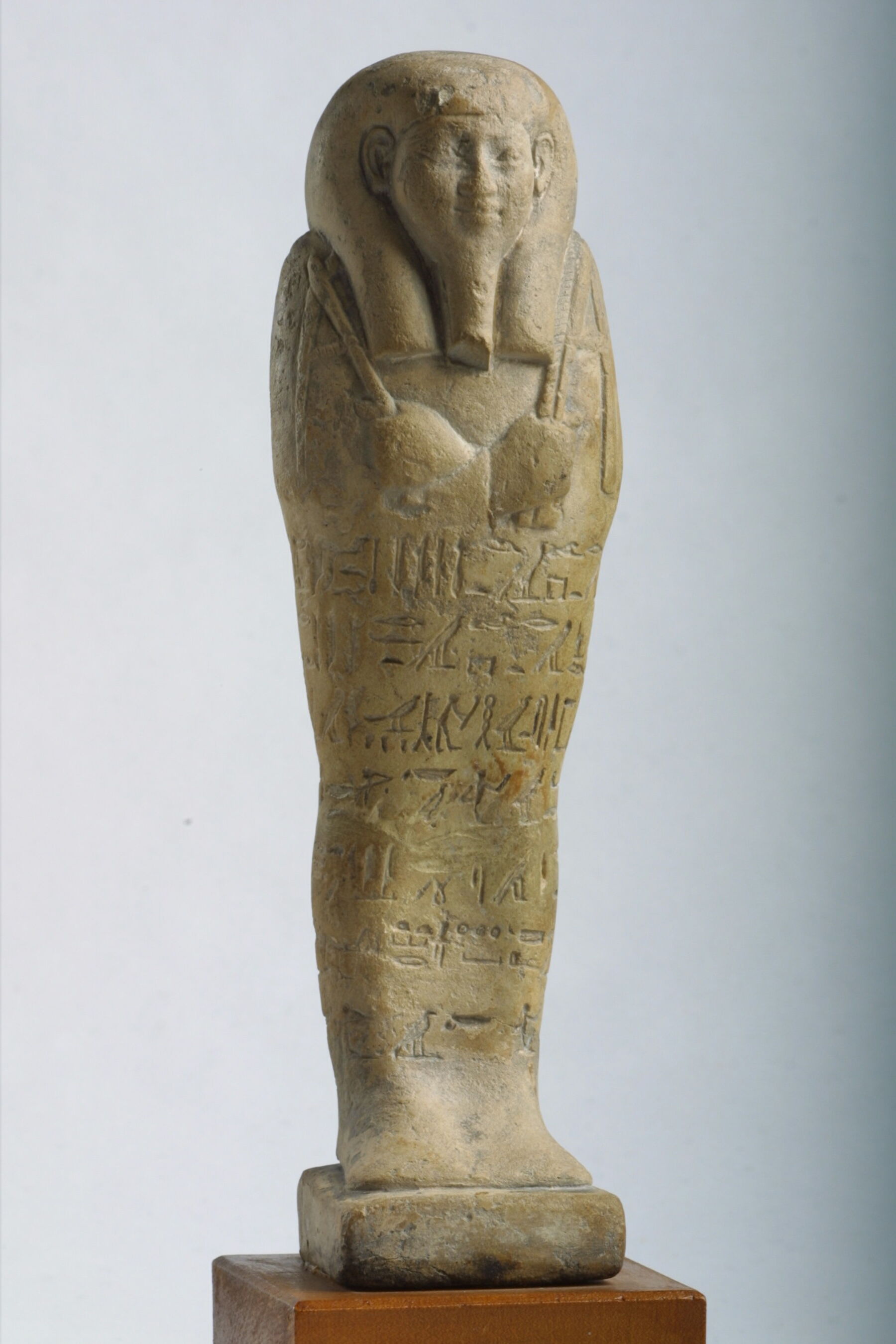This pale gray-green faience shabti belonged to a man called Horiraa, the Overseer of the Antechamber, who lived in Dynasty 26 during the reigns of Kings Necho II and Psamtik II (ca. 610–589 BCE).1 In his role, he was responsible for educating the royal children of Necho II and Psamtik II, and possibly even those of King Apries.2 Horiraa was a respected member of the elite and the royal court. Psamtik II gave Horiraa the significant honor of a “good name,” Neferibranefer. A good name was an additional name that incorporated part of the king’s throne name.3 Horiraa’s tomb was found intact on the southeast side of the famous Step Pyramid of Djoser in Saqqara, in Tomb LS 23. Approximately four hundred shabtis were discovered in two chests there.4
The shabti is mummiform and wears a plain Saite lappet wig and beard.5 His hands protrude through the mummy wrappings and grasp a hoe. In the right hand, Horiraa holds a rope over his shoulder secured to a small bag. He has a back pillar, a standard feature on shabtis from Dynasty 26 to the Ptolemaic period.6 The shabti spell is incised in a neat hand without horizontal guidelines to differentiate the rows.
EW
-
Janes, G. 2016. The Shabti Collections: 6. A Selection from World Museum, Liverpool. Lymm: Olicar House.. ↩︎
-
Janes, G. 2016. The Shabti Collections: 6. A Selection from World Museum, Liverpool. Lymm: Olicar House.. ↩︎
-
Meulenaere, Herman de. 1966. Le Surnom Egyptien a la Basse Epoque. Istanbul: Nederlands Historisch-Archaeologisch Instituut in het Nabije Oosten.; Oostenrijk, Jurgen van. 2012. “Individuality versus uniformity: twenty-sixth dynasty shabti groups from Saqqara.” Saqqara Newsletter 10: 58-61.; Janes, G. 2016. The Shabti Collections: 6. A Selection from World Museum, Liverpool. Lymm: Olicar House.. ↩︎
-
Porter, B., and R.L.B. Moss. 1974. Topographical Bibliography of Ancient Egyptian Hieroglyphic Texts, Reliefs, and Paintings. Vol. 3, Part II. Oxford: Clarendon Press.; Oostenrijk, Jurgen van. 2012. “Individuality versus uniformity: twenty-sixth dynasty shabti groups from Saqqara.” Saqqara Newsletter 10: 58-61.; Janes, G. 2016. The Shabti Collections: 6. A Selection from World Museum, Liverpool. Lymm: Olicar House.. ↩︎
-
Oostenrijk, Jurgen van. 2012. “Individuality versus uniformity: twenty-sixth dynasty shabti groups from Saqqara.” Saqqara Newsletter 10: 58-61.. ↩︎
-
Stewart, H.M. 1995. Egyptian Shabtis. Shire Egyptology 23. Princes Risborough: Shire Publications. https://catalog.lib.uchicago.edu/vufind/Alphabrowse/Home?source=series&from=Ägyptologische+Abhandlungen. ↩︎
Bibliography
- Janes 2016
- Janes, G. 2016. The Shabti Collections: 6. A Selection from World Museum, Liverpool. Lymm: Olicar House.
- Meulenaere 1966
- Meulenaere, Herman de. 1966. Le Surnom Egyptien a la Basse Epoque. Istanbul: Nederlands Historisch-Archaeologisch Instituut in het Nabije Oosten.
- Oostenrijk 2012
- Oostenrijk, Jurgen van. 2012. “Individuality versus uniformity: twenty-sixth dynasty shabti groups from Saqqara.” Saqqara Newsletter 10: 58-61.
- Porter and Moss 1974
- Porter, B., and R.L.B. Moss. 1974. Topographical Bibliography of Ancient Egyptian Hieroglyphic Texts, Reliefs, and Paintings. Vol. 3, Part II. Oxford: Clarendon Press.
- Stewart 1995
- Stewart, H.M. 1995. Egyptian Shabtis. Shire Egyptology 23. Princes Risborough: Shire Publications. https://catalog.lib.uchicago.edu/vufind/Alphabrowse/Home?source=series&from=Ägyptologische+Abhandlungen
